SFA missions are becoming a mainstream military activity. Despite this, we encounter flaws and challenges in the preparation and execution of these missions. In the Netherlands, the strategic value of SFA is not reflected in the current doctrine nor in the current organisation. As this article will show, doctrine is mostly absent. As such, most SFA-related activities are incorrectly labelled Military Assistance, which is the only SFA-related term in Dutch doctrine. In its organisation, the Dutch army prepares units, but deploys mostly its officers and senior enlisted personnel for SFA. Furthermore, personnel allocated to SFA-missions do not receive specialised training, nor are they purposely selected. By contrast, the US and the UK, both strategic partners of the Netherlands have identified the need for doctrinal clarity and specialised training and selection.
Captain I.L. Wiltenburg*
As a member of NATO the Netherlands have been involved in numerous Security Force Assistance (SFA) missions: in Africa in several ACOTA missions,[1] Dutch troops contributed to the OMLT Mission in Afghanistan (2006-2010)[2] and currently a Dutch contingent is deployed in the Middle East for the Capacity Building Mission in Iraq (CBMI).[3] The prevalence and popularity of these kinds of SFA missions is rising, since they allow governments, especially of small countries with major foreign interests such as the Netherlands, to influence foreign events and to show international commitment at limited cost in personnel and resources. Training, assisting and advising foreign forces as a military activity has therefore gained prominence over the last decade.
SFA missions are becoming a mainstream military activity.[4] Despite this, there are flaws and challenges in their preparation and execution. In the Netherlands, the strategic value of SFA is not reflected in the current doctrine nor in the current organisation.[5] As this article will show, doctrine is mostly absent. As such, most SFA-related activities are incorrectly labelled Military Assistance, which is the only SFA-related term in Dutch doctrine. In its organisation, the Dutch army prepares units, but deploys mostly its officers and senior enlisted personnel in SFA operations. Furthermore, personnel allocated to SFA-missions do not receive special training, nor are they purposely selected.
By contrast, the United States and the UK, both strategic partners of the Netherlands, have identified the need for doctrinal clarity and special training and selection.[6] As frontrunners in the practical and doctrinal development of SFA, the US and the UK function as benchmark nations for this article.
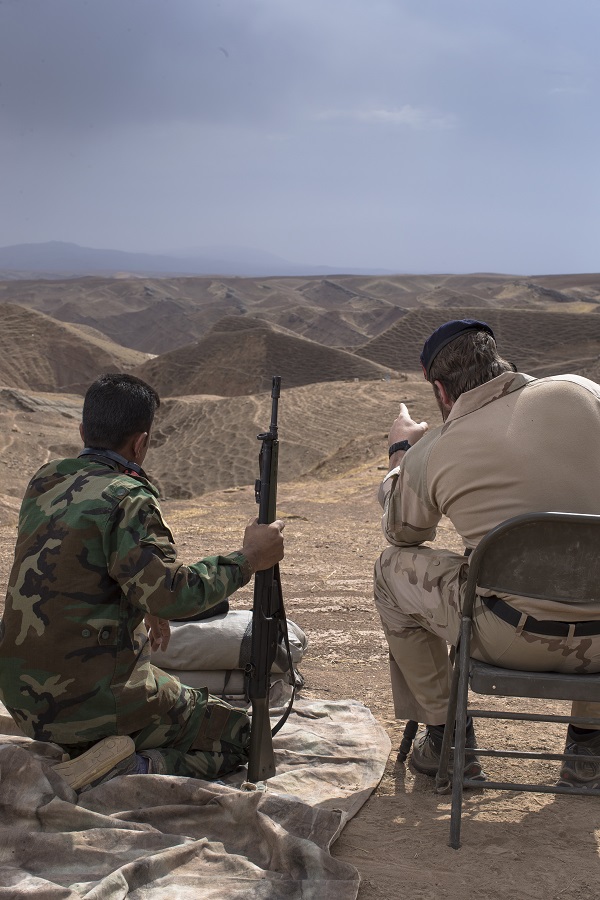
Training the Afghan National Army: The trend of increased SFA engagement warrants doctrinal clarity and organisational adjustments. Photo U.S. Army, Oscar Troncoso
The trend of increased SFA engagement warrants doctrinal clarity and organisational adjustments. The purpose of this article is to distinguish the organisational and doctrinal differences between the US, the UK and the Dutch armed forces in relation to missions involving training, advising and mentoring. By doing this, we can come to a proper categorisation for this type of operation and recommendations for organisational and doctrinal improvement.
The article starts by elaborating on the conceptual background of SFA. It then continues by explaining why the Netherlands doctrinal concept of Military Assistance – though similar in terminology – is not compatible with SFA missions performed by Dutch forces. Next, the doctrinal foundation and practical execution of the British Capacity Building missions will be explained, followed by the American interpretation of SFA. Finally, this article makes some recommendations for policy and organisational improvement.[7]
Conceptual background
The Oxford Research Group’s Remote Warfare Programme points at a globally diminishing number of large-scale deployments and an increase in light-footprint military interventions.[8] Governments simply want to avoid the enormous costs and uncertain consequences of military campaigns like the ones in Iraq and Afghanistan.[9] Furthermore, many nations are currently unable to deploy in force, as decades of budget cuts have taken their toll on staffing and combat readiness.[10] The US Department of Defense, for example, stated that ‘whenever possible, we will develop innovative, low-cost and small-footprint approaches to achieve our security objectives’.[11]
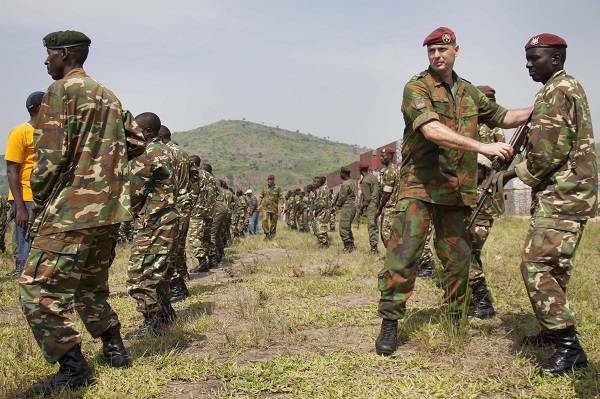
Missions like ACOTA allow governments, especially of small countries with major foreign interests such as the Netherlands, to show international commitment at limited cost in personnel and resources. Photo MCD, Eva Klijn
In a political environment where large-scale deployments are scrutinised by the public and the media, and where defence budgets have been strained during the last decade, small footprint deployments such as SFA missions have become a significant factor in the foreign policy of many nations. Internationally, the US and the UK have established dedicated units to address the need for training and advising and in 2017, NATO founded its SFA Centre of Excellence in Rome. In 2012, the Alliance stated that ‘NATO does not have a generic and overarching, comprehensive and unified concept for its contribution to developing security forces and their supporting institutions.’[12] NATO recognised at the time that the Alliance’s ability to train and develop local forces was a key capability gap.[13]
This key capability gap is addressed with SFA: producing combat power but not in the traditional sense. Instead of the preparation and deployment of one’s own units or formations, one now has to prepare other nations’ units and formations. In fulfilling this capability, one would expect that SFA missions are embedded in doctrine, and that these troops are selected, trained and equipped for these kinds of activities. In Dutch military doctrine, however, the only concept that describes such activities is Military Assistance. The term Military Assistance is not doctrinally coherent with the reality of current missions, as will be illustrated in the next section. The increase in operational practice is therefore not mirrored by conceptual clarity, leading to ambiguity about tasks and purpose of forces involved in these missions. Searching for a common doctrinal understanding, and a more applicable designation for this practice, other concepts and definitions that describe military activities involving the training, mentoring and equipping of foreign partners will be explored. Although not exhaustive, this article addresses the concepts of Capacity Building as practised by the United Kingdom, and Security Force Assistance as practised by the US, and explores whether these concepts are more compatible with the current Dutch practice and military concepts.[14]
The Dutch reference: Military Assistance
According to the Dutch Doctrine Publication DP 3.2, Military Assistance is a Special Forces prerogative.[15] The Dutch Special Forces include Military Assistance as one of their three main activities, next to Direct Action (DA) and Special Reconnaissance (SR). The Dutch Special Forces refer to the NATO Military Assistance Handbook as their Military Assistance doctrine. The latter defines Military Assistance as ‘a broad category of measures and activities that support and influence critical friendly assets through organizing training, advising, mentoring, or the conduct of combined operations.’[16]
This Dutch/NATO doctrine defines the concept as a Special Forces task, and notably restricts the activity to critical friendly assets. As this article will show, both SFA and Capacity Building rest on the idea that these military activities are not a Special Forces prerogative. This way, regular forces can take over operations from Special Forces where possible, freeing them for special tasks that are not within regular forces capabilities.
A Dutch Marine instructing an Iraqi soldier: the concept of Military Assistance as a SOF prerogative contradicts the deployment of forces to several missions. Photo MCD, Hille Hillinga
As the contemporary Dutch training missions are for a major part run by regular units, the concept of Military Assistance as a SOF prerogative contradicts the deployment of forces to the ACOTA, CBMI and OMLT missions in this context. Furthermore, it can be argued that Dutch forces do not operate with friendly assets that can be classified as ‘critical’. Critical assets would imply that these forces have a key role in Dutch foreign policy. Since Dutch military commanders are not leading any of the missions, and the Dutch numerical footprint is relatively small, it would suggest that Dutch soldiers involved do not contribute operationally or strategically to any of the missions mentioned. These Dutch troops are merely deployed to enhance the posture of the Dutch forces, and to signal the willingness of the Dutch government to contribute to conflict resolution in an international setting. Hence, Dutch forces might only be contributing to political strategic targets, but in a Clausewitzian military strategic sense, such Dutch military efforts support only means to an end rather than critical assets.
So, if the missions in which Dutch forces are currently involved in are not coherent with the doctrinal definition of Military Assistance, how can we place these activities in current military doctrine? In order to answer this question, I will now explore two other concepts that involve training, mentoring, advising and equipping foreign forces: British Capacity Building and American SFA, to assess whether these are compatible with Dutch operational art and practice.
Capacity Building in British military doctrine
In British Army doctrine, Capacity Building’s conceptual importance is apparent from its status as a tactical function.[17] Capacity Building is set next to the conventional tactical functions like command, intelligence, manoeuvre, fires, information activities, protection and sustainment.[18] The Dutch army on the contrary does not recognise Capacity Building as a function, neither does it acknowledge the term in the army doctrine. According to the British Army Doctrine, Capacity Building operations cover the ‘full spectrum approach to increase a partner nation’s ability to achieve self-sufficiency, typically through improved governance, security, human capital, development and reconstruction.’[19] More specifically, security capacity building is ‘an integrated approach to the generation, employment and sustainment of local, partner-nation, or international security forces in support of a legitimate authority. As an (operational) activity, it is most likely to take place in support of security sector reform.[20] [21]
Capacity Building is thus an activity within the Security Sector Reform (SSR) scope, in which the recipient of the effort is schooled in a more efficient way of employing his personnel and equipment. Improvements in tactics, doctrine, leadership, human rights, health and safety, intelligence gathering and logistics would enable the recipient to conduct operations more effectively and efficiently. Capacity Building has been an important aspect during British deployments because a stable security situation, which frequently implies Security Sector Reform, is often a prerequisite for armed forces to redeploy, stressing the strategic value of Capacity Building.[22] British troops have been recently involved in numerous Capacity Building missions, for instance in Botswana, Sierra Leone, Afghanistan, Nigeria and Mali. These missions included Capacity Building before, during and after conflicts. During the deployments, the British engaged in activities such as leadership training and tactical level exercises.[23] As the activities of the British are similar to the Dutch deployments mentioned before, it is interesting to assess if doctrinal similarities can be found.
Although neither NATO nor the US and the Dutch define Capacity Building, some common ground can be found between Dutch and British conceptual thinking in SSR. The British doctrine views Capacity Building as part of SSR and Dutch doctrine implicitly shares this view, as it states that ‘SSR entails activities designed to assist in the rebuilding or restoration of organisations in a country’s security sector so that the country can ultimately provide independent, legitimate and effective security for itself and its citizens.’[24] The conceptual disparity between the UK and the Netherlands can be found in the Dutch assertion that SSR is to be conducted in the ‘normalisation phase,’[25] meaning at the end of the conflict, rather than before or during conflict or crisis. This conceptual difference, however, cannot be surveyed empirically, as the current Dutch missions are conducted before, during and after conflict. The UK doctrine specifies that although Capacity Building can be conducted ‘outside of operations, it can also feature during conflict or crisis.’[26]
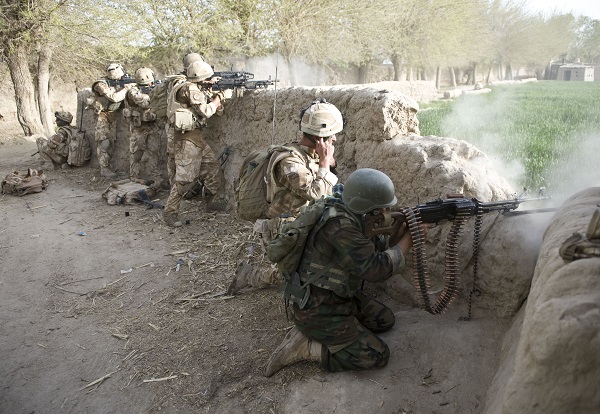
Since training, mentoring and advising are distinct military activities, the British armed forces have acknowledged that soldiers performing such tasks need to be specialised. Photo UK Ministry of Defence, Dave Husbands
Since it has been established that training, mentoring and advising are distinct military activities, the British armed forces have acknowledged that soldiers performing such missions need to be specialised. As such, it has been decided that Capacity Building tasks can and often must be conducted by appropriately skilled and prepared force elements.[27] Consequently, and in order to improve results, two battalions of UK regular infantry have been reassigned to the Specialised Infantry Group, with two additional battalions as per 2019.[28] These units are regionally aligned and offer long-term Capacity Building to partner nations.[29] The battalions can operate in remote and high-threat environments and are able to offer partnering and accompanying partner forces during crises. Working under the wings of the 1(UK) Division means that activities will be well-integrated with the activity of the Regionally Aligned Brigades.[30]
The British vision is noteworthy for various reasons. In the first place, it acknowledges Capacity Building as a key function in military operations. Secondly, the British allow regular and Special Forces to cooperate in this type of operation.[31] Thirdly, the need for specially trained and equipped troops to perform well in these kinds of missions is recognised. The reorganisation of British forces in order to accommodate this new capacity in the armed forces, as well as the doctrinal changes demonstrate the commitment of the British Ministry of Defence to this new concept, and the conviction that this is an important tool in foreign relations. Interestingly, a similar trend is visible in the US Armed Forces, under the Security Force Assistance moniker.
United States Security Force Assistance
After the fall of the Taliban government in Afghanistan in 2002 and Saddam Hussein’s Iraqi regime in 2003, SFA became a major pillar of global American national security policy. In the 2012 Defence Strategic Guidance, SFA was mentioned as central to effective stability operations in an era in which US forces will no longer be able to execute these by themselves.[32] Although the US has a long history of assisting other nations’ forces, for example in Iraq, Afghanistan, Vietnam, South Korea, Colombia, Greece and Turkey, the current missions emphasise the need for doctrinal and organisational adjustment. In a recent interview and an article in the Joint Forces Quarterly, general Joseph L. Votel, commander of US CENTCOM, reiterated the need for the extension of SFA doctrine.[33] As an extension of this policy, the US Army established the first of six planned Security Force Assistance Brigades (SFABs) in 2017. The SFABs are the latest manifestation of American SFA policy, and represent an attempt to reduce the burden on Special Operations Forces that traditionally conducted these missions, but have become overtasked due to the Global War on Terror.[34]

As Commander of US CENTCOM, general Joseph Votel reiterated the need for the extension of SFA doctrine. Photo U.S. Air Force, Amanda Manteufel
The SFABs are similar to the British Specialised Infantry Battalions. SFABs are dedicated to ‘develop the capacity and capability of foreign security forces to facilitate the achievement of US strategic objectives, in coordination with joint, interagency, and multinational forces.’[35] These brigades consist of 530-700 NCOs and officers, specially trained at the Military Assistance Training Academy at Fort Benning, Georgia. The purpose of these new formations is to free regular Brigade Combat Teams (BCTs) from SFA missions – allowing BCTs to focus on conventional warfare – and to improve on the hitherto ad hoc nature of training and assistance missions.[36] The regular BCTs are free to focus on combatting near-peer adversaries.[37] When the need arises, the SFABs can be reinforced with vehicles and personnel in order to function as any form of BCT (Stryker, armoured, or infantry).
Doctrinally, the mission of the SFABs is derived from of the Department of Defense’s Joint Publication Doctrine (JP), which states that ‘Security Force Assistance is the Department of Defense’s contribution to a unified action effort to support and augment the development of the capacity and capability of foreign security forces and their supporting institutions to facilitate the achievement of specific objectives shared by the United States Government.’[38] By contrast, NATO’s Allied Joint Doctrine Publication states that Security Force Assistance ‘includes all NATO activities that develop and improve, or directly support, the development of local forces and their associated institutions in crisis zones.’[39] The UK follows this definition closely.[40] However similar, the US has a provision that SFA should facilitate the achievement of objectives shared with the US Government. The US definition also demands a more specified objective and introduces the terms ‘capacity and capability’. According to both British and US doctrine, SFA is practiced principally during crisis or conflict.[41]
The US army, like the British, has recognised the necessity for specially trained soldiers to perform the task and to operate together with different partners, domestically as well as internationally. In order to ensure that SFAB personnel have the right qualifications, SFAB personnel must have previous experience in similar advisory positions.[42] SFAB personnel also have to pass the two-week Military Advisor Training Academy (MATA) course to acquire the necessary skills and knowledge to perform well during a deployment. The course presents the various host-nation challenges anticipated in an underdeveloped country.
The strategic importance of SFA to the US is shown by the establishment of six SFABs, with competitive selection for schooling and training. The American SFA approach is also interesting because capability is included, as well as capacity. This indicates that the US is not only interested in boosting existing forces, but is also willing to introduce new capabilities to the recipient forces, acting as a force multiplier. The necessity of American SFABs was exemplified by their first deployment to Afghanistan in 2018, to address the failing security situation there. Reportedly, the Taliban controls and/or contests over half the districts in the country.[43]
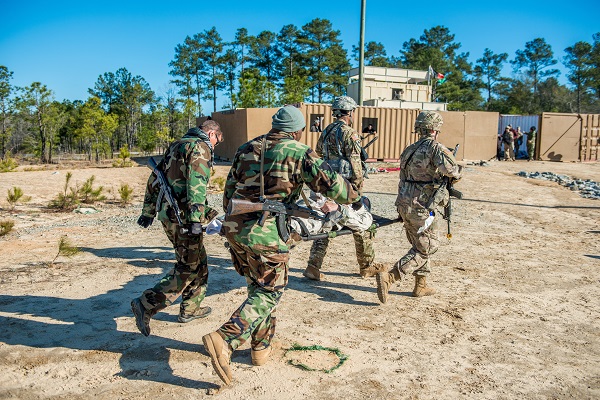
American SFAB personnel have to pass the two-week Military Advisor Training Academy (MATA) course to acquire necessary skills and knowledge. Photo U.S. Army, Patrick Albright
As the Dutch armed forces do not mention SFA, doctrinal overlap is hard to establish. As SFAB personnel will train, advise and assist indigenous forces in planning and executing combined operations, their mission is similar to the Dutch OMLT teams in Afghanistan in 2006-2010. As both the SFABs and OMLT operate in a conflict situation, the similarities extend not only to the role and tasks, but also to the phases of the conflict. The CBMI mission in Iraq is also coherent with American SFA doctrine, although it is not possible for most Dutch CBMI personnel to conduct combined operations due to national caveats; their tasks are limited to training, although the mission is conducted in a conflict area.[44]
Conclusion
Dutch military doctrine does not support deployment by regular forces involving training, advice and assistance. Nonetheless, a survey of the doctrine of two strategic partners concerning training, advising, equipping and mentoring foreign forces shows that the British concept of Capacity Building is coherent with Dutch participation in ACOTA missions. ACOTA missions are not conducted in conflict or crisis situations and are fully compliant with the Security Capacity Building definition as stated in the UK Army Field Manual. The CBMI mission is compliant with US doctrine on SFA, as the mission is conducted during a conflict or crisis and allows for direct support of friendly forces. The OMLT mission in Afghanistan finds itself in the grey area between post-conflict Capacity Building and assistance during crises or conflict. Either way, it can be concluded that these contemporary Dutch deployments can be conceptually related to US and UK doctrine.
Additionally, the US and UK have committed numerous formations or units in order to professionalise Security Force Assistance and Capacity Building. Both nations have observed that senior enlisted personnel and officers whose job is to train, advise and mentor foreign forces require additional training and education, and that selecting personnel from combat units for training missions is detrimental to the combat-readiness of those units.
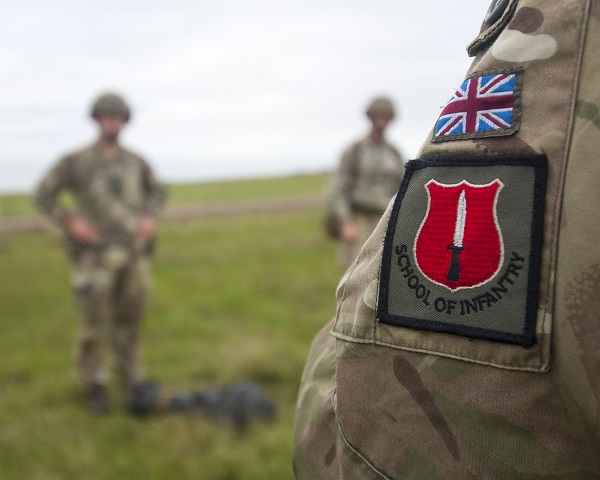
To integrate aspects of the British and American approaches to Military Assistance into Dutch military operations would be beneficial to current (and future) Dutch deployments. Photo MCD, Hille Hillinga
The US and the UK, two strategic partners of the Netherlands, have understood the need for a sound doctrine, in combination with thorough selection, education and training of advisors, and the missions of all three nations have substantial overlap. Therefore, the question remains why the Dutch armed forces are reluctant to adjust their doctrine or introduce organisational adjustments such as additional training and education, or personnel selection. To integrate and emulate aspects of the British and American approaches to military assistance into Dutch military operations would be beneficial to current (and future) Dutch deployments that are a mixture of UK Capacity Building and US Security Force Assistance concepts.
As this article has highlighted, SFA as a military activity has little discourse, and scant foundation in Dutch military theory and doctrine. Since such missions, regardless of the term used to describe them, are expanding in number due to perceived low costs, small footprint, lack of public scrutiny and a perceived positive cost-benefit ratio, further research is needed to establish the benefits and challenges of these missions.[45] At present, defining military activities that cover the terrain of training, equipping and mentoring other forces may lead to ambiguity. The different terms cover activities on the tactical, operational and strategic level. These terms might or might not include equipping, training and conducting joint operations. SFA might be performed by regular forces, specially trained forces or SF, and the focus could be on the receiving partner’s military, civil agencies or both. It is also not clear whether SFA is a different way to project military power, a method of cost-reduction, or a tailor-made form of military deployment.
Finally, Military Assistance is not a term applicable to Dutch training missions. As an alternative, Security Force Assistance is the preferable designation. It covers the Dutch activities completely, it connects the Dutch armed forces doctrinally with the US, UK and NATO, and it improves the interoperability capabilities of the Dutch military, by building on allied research, experiences, and doctrine. Pursuing these concepts could improve the capabilities of the forces involved in SFA, promote the safety and stability of weak states, and diminish the pre-conditions for insurgency and terrorism.
* Captain Ivor Wiltenburg is a PhD candidate in Military Operational Science at the Royal Netherlands Defence Academy.
[1] The Africa Contingency Operations Training and Assistance (ACOTA) programme is funded and managed by the U.S. Department of State. The initiative is designed to improve African militaries’ capabilities by providing selected training and equipment necessary for multinational peace support operations. The Dutch government joined the programme in 2008 and deployed training teams to Uganda, Burundi, Burkina Faso, Niger and Rwanda.
[2] The Operational Mentor and Liaison Team (OMLT) programme is an important part of NATO-ISAF’s contribution towards the development of the Afghan National Army (ANA). OMLTs provide training and mentoring to the ANA. They also serve as a liaison capability between ANA and ISAF forces, coordinating the planning of operations and ensuring that the ANA units receive necessary enabling support (including Close Air
Support, Casualty Evacuation and Medical Evacuation).
[3] The Capacity Building Mission in Iraq (CBMI) provides training and equipment for both regular and special Iraqi Forces, as well as Kurdish Peshmerga forces.
[4] M. Shurkin, J. Gordon IV, B. Frederick and C.G. Pernin, Building Armies, Building Nations: Towards a New Approach to Security Force Assistance (Santa Monica, Rand Corporation, 2017) xiii.
[5] Both The Netherlands Defence Doctrine, as well as The Netherlands Doctrine Publication 3.2 (Army) and Dutch naval/marine doctrine , do not mention SFA type activities other than Military Assistance. This article considers doctrine as the formal expression of military thought over a certain period. Therefore, any writing on this topic that is not a formal MoD publication is excluded. The author acknowledges the possibility of informal writings on lessons learned, bulletins or confidential handbooks. All open source doctrine on this topic available to the author was reviewed and used for this article.
[6] The case studies in this article are limited to the US and UK army doctrines, and the Netherlands Army and Defence doctrine.
[7] This article is part of broader research into SFA. For this article, the scope is limited to the conceptual and executive levels of the US, UK and the Netherlands.
[8] T. Watts and R. Biegon, ‘Defining Remote Warfare: Security Cooperation’, Remote Control Project (London, Oxford Research Group, 2017) 2.
[9] S. Watts, P.B. Johnston, et al., Limited Intervention. Evaluating the Effectiveness of Limited Stabilization –Limited Strike, and Containment Operations (Santa Monica, Rand Corporation, 2017) 17-19.
[10] See https://www.dw.com/en/germanys-lack-of-military-readiness-dramatic-says-bundeswehr-commissioner/a-42663215; https://www.rtlnieuws.nl/nederland/artikel/3550896/geheim-rapport-landmacht-het-materieel-oud-versleten-en-daardoor and https://www.bbc.com/news/business-43365208.
[11] Sustaining US Global Leadership: Priorities for 21st Century Defense (Washington, D.C., U.S. Department of Defense, 2012) 3, 6.
[12] NATO Allied Command Transformation, Security Force Assistance (SFA) Conceptual Study (2012) iii.
[13] Ibid, 1.
[14] In the current military and scholarly discussion on the topic many more terms have been coined that, at least partially, cover the subject. These include Security Cooperation, Building Partner Capacity, Security Assistance, Limited Intervention, Remote Warfare, Vicarious Warfare, Proxy Warfare and more. For this article, the scope will be limited to the two concepts mentioned before.
[15] Doctrine Publication 3.2, Land Operations (Amersfoort, Dutch Ministry of Defence, 2014) 67.
[16] NATO Special Operation Forces Doctrine Military Assistance Handbook (Brussels, NATO, 2016) 10.
[17] In the tactical function sense, Capacity Building is described as ‘’ those actions taken to improve military, and when necessary, civil, security and infrastructure capability.’ Source: Army Field Manual Tactics for Stability Operations: part 5 Military Support to Capacity Building, 1-2.
[18] Land Warfare Development Centre, Land Operations (London, Ministry of Defence, 2018) 32.
[19] Army Field Manual Tactics for Stability Operations: part 5 Military Support to Capacity Building, 1-1.
[20] Ibid, 1-2.
[21] Security Sector Reform is considered to be activities undertaken by a nation and its partners to improve the way it provides safety, security, and justice to its citizens. Source: http://www.dtic.mil/dtic/tr/fulltext/u2/a513157.pdf.
[22] C. Freeman, ‘Introduction: Security, governance and statebuilding in Afghanistan,’ in: International Peacekeeping 14 (1) 1 (London, Routledge, 2007) 6.
[23] Army Field Manual Tactics for Stability Operations: part 5 Military Support to Capacity Building, 8-6.
[24] Netherlands Defence Doctrine (The Hague, Ministry of Defence, 2012) 26.
[25] According to the Dutch Defence Doctrine, the normalisation phase is at the end of the conceptual conflict cycle: prevention phase, intervention phase, stabilisation phase, normalisation phase. In the normalisation phase, the emphasis is on sustainable development and reinforcement of the local administration and the security sector, taking account of local culture and tradition. Military input is reduced further in this phase and will eventually focus on activities related to Security Sector Reform, which will start in the stabilisation phase. Source: Netherlands Defence Doctrine, (The Hague, Ministry of Defence, 2012) 26.
[26] Army Field Manual Tactics for Stability Operations: part 5 Military Support to Capacity Building, 1-2.
[27] Land Operations, Army Doctrine Publication, Land Warfare Development Centre AC 71940 (Warminster, Ministry of Defence) 14.
[28] There are currently two battalions assigned to the Specialised Infantry Group (1st Bn The Royal Scots Borderers, 4th Bn The Rifles). In 2019 two more battalions will be added (2nd Bn Princess of Wales’s Royal Regiment and the 2nd Bn Duke of Lancaster’s Regiment. Source: E. Knowles and A. Watson, Remote Warfare. Lessons Learned from Contemporary Theatres (London, Remote Warfare Group, 2018) 11. Furthermore, an additional Gurkha battalion might be established, also in the Specialised Infantry role: Source: https://www.janes.com/article/81826/uk-to-recruit-more-gurkha-soldiers.
[29] Regionally Aligned units focus on a certain region, such as the Middle East. This advances their understanding of language, culture, terrain and climate.
[30] The Regionally Aligned Brigades (RAB) are the Army’s primary interlocutor to regional actors, responsible for providing land advice to the MoD for Defence Engagement and the design of capacity building to achieve strategic effect. The RABs are the Army point of contact for all regional and country matters, responsible for: understanding of partner nation land capabilities and development of land delivery plans and their delivery as the Army’s Coordinating Authority and the force preparation of Force Elements deploying to their aligned theatre. Source: Army Field Manual Tactics for Stability Operations: part 5 Military Support to Capacity Building, 4-6.
[31] Army Field Manual Tactics for Stability Operations: part 5 Military Support to Capacity Building, 15.
[32] Sustaining US Global Leadership: Priorities for 21st Century Defense (Washington, D.C., U.S. Department of Defense, January 2012) 6.
[33] Joseph L. Votel, ‘The By-With-Through Approach,’ in: Joint Forces Quarterly, (Washington D.C., National Defense University Press, April 2018) 46.
[34] Ibid, 39.
[35] See: https://fortbenningausa.org/wp-content/uploads/2018/04/TCM_SFAB_2018.pdf.
[36] See: https://www.army.mil/article/195178/first_security_force_assistance_brigade_training_for_deployment.
[37] See: https://www.military.com/daily-news/2018/05/18/army-announces-bases-where-three-new-sfabs-will-be-stationed.html.
[38] USA Joint Publication JP 3-22, Foreign Internal Defense (Washington, D.C.) I-16.
[39] NATO Standard AJP-3.16, Allied Joint Doctrine For Security Force Assistance (SFA) (Brussels, NATO Standardization Office, 2016) 1-1.
[40] The UK definition is similar, it does, however, replace ‘NATO’ with ‘UK or Coalition Forces’ and thus reads ‘SFA includes all UK or Coalition activities that develop and improve, or directly support, the development of local forces and their associated institutions in crisis zones.’
[41] NATO Standard AJP-3.16, Allied Joint Doctrine For Security Force Assistance (SFA) 7-4.
[42] https://www.military.com/daily-news/2018/05/18/army-announces-bases-where-three-new-sfabs-will-be-stationed.htmlhttps://www.military.com/daily-news/2018/05/18/army-announces-bases-where-three-new-sfabs-will-be-stationed.html.
[43] See: https://www.longwarjournal.org/archives/2018/09/mapping-taliban-controlled-and-contested-districts-in-afghanistan-lwj-vs-us-military-assessments.php.
[44] See: https://www.defensie.nl/onderwerpen/missie-in-irak-en-oost-syrie/militaire-bijdrage accessed 06-09-2018, and https://www.nrc.nl/nieuws/2017/07/17/instructeurs-leren-geharde-peshmerga-beter-schieten-12131526-a1567020.
[45] The perceived low cost of this type of mission is subject to a political and scholarly discussion that lies outside the scope of this article. The research of which this article is part will address this question.